Published 5 SEP 2024
Dor Guez
Not knowing is a good place to start
Opening – 13 SEP 2024, 6-10 pm
13 SEP until 2 NOV 2024
Dor Guez Munayer’s works deal with traces and scars. Interrogating personal experiences and memories alongside official narratives of the past, his practice raises questions about contemporary art’s role in narrating unwritten histories and re-contextualizing visual and written archives. Guez’s solo exhibition Not knowing is a good place to start uncovers the multiple facets between first-hand accounts and dominant cultural narratives using archival materials from both public and private sources. Guez was born in Jerusalem to a Palestinian mother and a father from a family of Arab-Jewish immigrants from North Africa. This exhibition highlights the artist’s interest in German history and his ongoing engagement with his family’s and communities’ histories across Jaffa, Lydda, Jerusalem, and Gaza. This exhibition was assembled during the past year in which the artist and his family experienced an unprecedented war in their homeland.
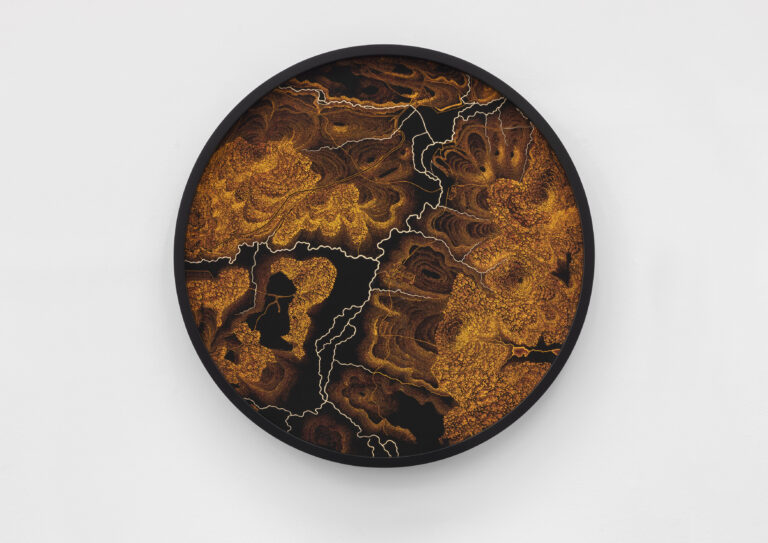
Dor Guez, Amid Imperial Grid (Germany) #4, 2023
Archival Inkjet Print
Diameter 120 cm
Courtesy the artist and carlier | gebauer, Berlin/Madrid
Photo © Andrea Rossetti
Guez’s ongoing photographic series of immigrants’ and refugees’ suitcases, draws on the exile of the artist’s father’s family (Guez) from Tunisia after the Nazi occupation, as well as the displacement of his mother’s family (al Munayer), whose property was nationalized during the 1948 war while they hid in the basement of St. George’s Church in Lydda. Guez unfolds the “afterlife” of these objects, which were passed down through generations. He photographs the six outer faces of each suitcase he chose, then combines them into one surface, one flattened perspective, so the volume of the object, what it can potentially contain, unfolds into a singular point of view. What do people take with them when forced to leave their homes? Every detail of the final photographic image explores the physical traces of time—scars from journey to destination. The show presents Suitcase No.2 and Suitcase No.3.
The loss of Guez’s family estate in Lydda (1948) resonates with present events, as members of his family in Gaza once again sought refuge in a church after their homes were destroyed. When food was scarce, Guez’s relatives relied on nature for sustenance, harvesting a local wild plant called Khobiza. This plant, associated with Palestinian cuisine, grows in fields, abandoned sites, and home gardens. Khobiza (from the Arabic word for bread) has historically served as a bread substitute during wars, droughts, and sieges. Guez’s Khobiza series, part of a broader body of work, depicts various parts of the plant after harvest, appearing to sink into or float out of the photographic paper.
The sculpture Nest came into being during last summer. Pigeons entered Guez’s studio in Jaffa in his absence, looking for a place to nest. They flew in through a window that was left open, searching for a suitable site, a protected and sheltered location for their chicks. Time after time, the preferred location was on the tall bookshelf in the artist’s library, on a biblical dictionary in Hebrew and Aramaic from 1977.
The exhibition includes a body of work formerly presented as part of Guez’s solo museum exhibition Amid Imperial Grids (2023) at the Felix Nussbaum House, Osnabrück. In Guez’s series of prints, Amid Imperial Grids, the artist has manipulated topographical maps of zones that connected Germany to different nations, all dated from the turn of the 20th century. By removing nearly all human traces – names of cities, towns, and national borders and filling in the gaps in the ‘missing’ visual information– Guez has produced a raw topography freed of geopolitical regulations and human constructions. He then altered these landscapes by transforming them into negative images. The results are abstractions stripped of all that defines them politically and historically and bring the maps closer to what feels like a human body.
Additionally, Guez has also made a profound change in the boundaries of the maps themselves. They are all cut in the form of a circle – an optical alter that makes their inherent orientation redundant: the viewers wander around them without being able to coordinate themselves, without being able to (un)locate where home is.
Scattered throughout the exhibition, Guez’s sculptural intervention Vertical Axis is inspired by the first device invented by Egyptian scientists to mark a straight vertical line using gravity—weights hanging by a thread.
Dor Guez Munayer is a Jaffa-based artist and an educator. Guez’s practice includes photography, video, installations, sculpture, and performance. In the past 20 years, his scholarly and artistic work have focused on archival materials and photographic practices, as well as the mapping traces of at times violent disruptions in the landscape. Guez’s latest overview, Catastrophe, at the Museum of Modern Art Bogota, spans a wide range of works showcasing the artist’s committed engagement with his community and the ever-unfolding studies of the Middle East and North Africa.
Guez’s work has been displayed in solo exhibitions at the Laboratorio Arte Alameda, Mexico City (2023); Felix Nussbaum Museum, Osnabrück (2023); MAMBO: Museum of Modern Art, Bogota (2022); Kunst im Kreuzgang, Bielefeld (2021); Futura Gallery, Prague, (2020); American Colony Archive, Jerusalem (2019); MAN Museum, Nuoro (2018); the Museum for Islamic Art, Jerusalem (2017); the Museum of Contemporary Art, Detroit (2016); the Institute of Contemporary Arts, London (2015) the Rose Art Museum, Brandeis University, Massachusetts (2013); The Mosaic Rooms, A.M Qattan Foundation, Centre for Contemporary Arab Culture & Art, London (2013) and the KW Institute for Contemporary Art, Berlin (2010).
Guez’s works are included in public collections such Tate Modern London, Center Pompidou Paris, Guggenheim Abu Dhabi, LACMA; Los Angeles County Museum of Art, Princeton University Art Museum, The Jewish Museum New York, Rose Art Museum, FRAC collection Marseille, Museum of Modern Art Bogota, and more.
Paul Pfeiffer
Revelation 21
Opening – 13 SEP 2024, 6-9 pm
13 SEP until 14 NOV 2024
Carlier | gebauer is delighted to present Paul Pfeiffer’s solo show „Revelation 21”. Engaging with the topics of spectatorship, architectural structures and mass media, this exhibition features sculptures from the “Incarnator” series and photographs from the series “Temple of Solomon (After Villapando)” alongside the heteronomous body of work titled “Vitruvian Figure”. This exhibition shows for the first time the early prints – large-scale sepia works depicting architectural floorplans of significant Western Churches – in context with the latest sculpture. Following almost 20 years, in 2008, Pfeiffer creates the first model: a miniature of the Sydney Olympic Stadium expanded by Pfeiffer to the capacity of 1,000,000 viewers. In 2009, Pfeiffer slices a model of London’s reconstructed Wembley Stadium to a quarter of the inner grandstand. Reflected by a mirrored glass, this work conjures the illusion of a complete circle.
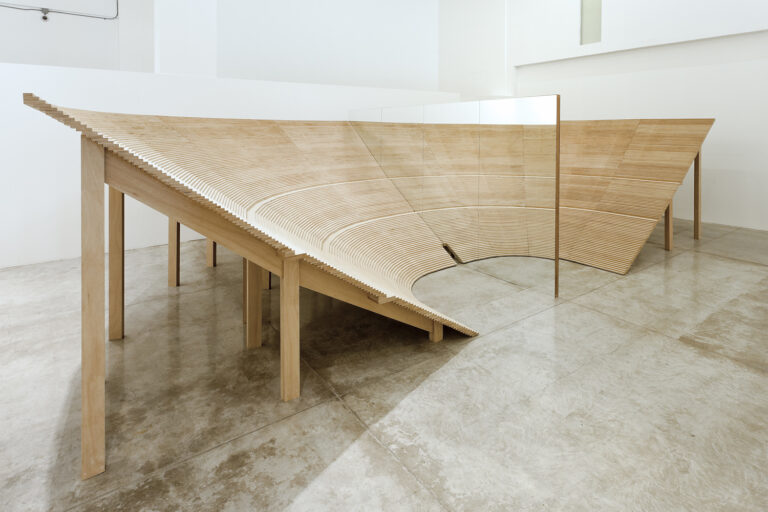
Exhibition view: Paul Pfeiffer, VITRUVIAN FIGURE, the Museum of Contemporary Art and Design (MCAD), Manila (Philippines), 2015
Courtesy of the artist and carlier | gebauer, Berlin/Madrid
Photo © 2015 MCAD Manila
The to this date final “Vitruvian Figure” from 2015 is carried out in plywood and forms a half-circle divided by a mirror. The two meters high sculpture is based on the Philippine Arena, world’s largest indoor arena located outside of Manila. This colossal building was built in 2014 by religious organization “Iglesia ni Cristo”, a Christian church founded in the Philippines in 1914. In the wake of anti-colonial movements, it offered an opposition to the Catholicism imposed by the Spanish colonial rule. Today the arena continues to host the congregations of “Igleasia ni Christo” as well as sport events and music concerts.
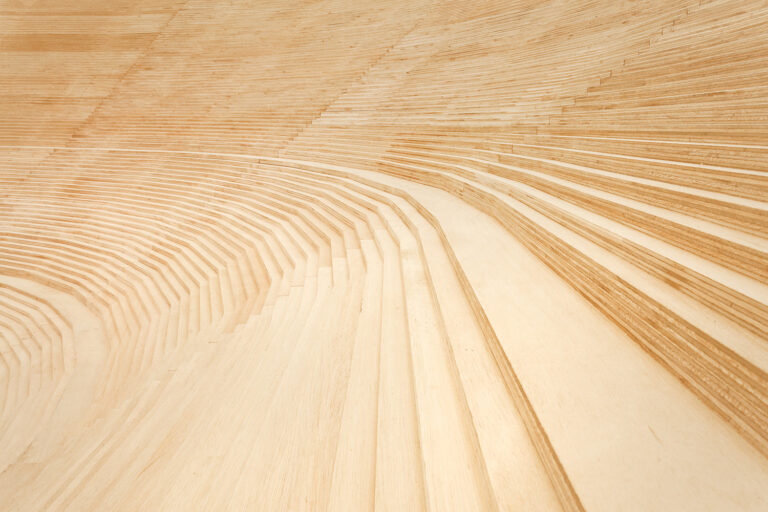
Exhibition view: Paul Pfeiffer, VITRUVIAN FIGURE, the Museum of Contemporary Art and Design (MCAD), Manila (Philippines), 2015
Courtesy of the artist and carlier | gebauer, Berlin/Madrid
Photo © 2015 MCAD Manila
Pfeiffer’s work reflects the vast proportions of the arena while containing it within a gallery space. The sculpture itself appears as a paradoxical model, in the relation to the spectator the model still looms overwhelming in size, while simultaneously representing a miniaturized stadium, with 119 abstracted rows of seats. A “mimetic intensification”[1] plays out on the scale of the work. It places the spectator in a peculiar position of encountering an architectural structure, which appears distinctively as a miniature mimicking an object much larger and yet its scale feels enormous when confronted with. Simultaneously, it allows the viewer an otherwise impossible, nearly bird-eye like perspective of the stadium it represents, enabling them to overview the structure and thus intensifying its perception. The arena is however deployed of the crowd, the event. In the widest sense a device for spectatorship, it becomes here its object. The focus is directed on its form, an inverted dome. A centralized, symmetrical shape it seems to represent the ideal form, which can be mirrored into completion and create the illusion of a whole.
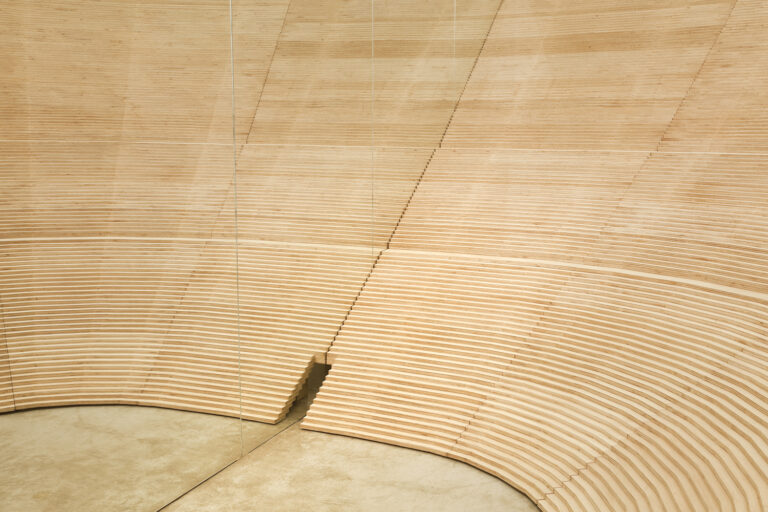
Exhibition view: Paul Pfeiffer, VITRUVIAN FIGURE, the Museum of Contemporary Art and Design (MCAD), Manila (Philippines), 2015
Courtesy of the artist and carlier | gebauer, Berlin/Madrid
Photo © 2015 MCAD Manila
The search for the perfect form, which finds its expression in symmetry, occupied ancient roman architect and engineer Vitruvius in the first century BC. The third books of his treatise “De Architectura” titles “On Symmetry in Temples and in the Human Body”, introducing the foundational metaphor of architecture as a reflection of the human body. Pfeiffer’s early “Vitruvian Figures” elaborate on this metaphor by eponymously titling architectural floorplans after Leonardo da Vinci’s famous drawing illustrating man’s ideal proportions. The open spaces perforated by columns as well as the walls and niches in these floorplans raise the question of opening, opening up to another body, to the potentiality of encompassing another body, of man as a penetrable being. There is a sexual undertone in these works, becoming overt in a reading of the Vitruvian figure as two copulating men[1]. Contesting the notion of architecture as a stand in for the universal body, Pfeiffer’s “Vitruvian Figures” draw our attention to the particular, individual bodies which might inhabit these buildings.
Linking architectural plans and speculative models by title and timing, these works evoke a representation of what is not there, models or plans for what is to come, precise and generative at the same time. Are these plans and models made after these respective buildings or are they made for these buildings? In “Revelation 21”, a chapter of the bible the end of the world and the following new Heaven and Earth is described. Curiously this new world is envisioned in an architectural language, stating exact measurements and material specification. In a similar vein as above, one could ask: when describing this new world, is the revelation a stand-in for a new world or after an old world?
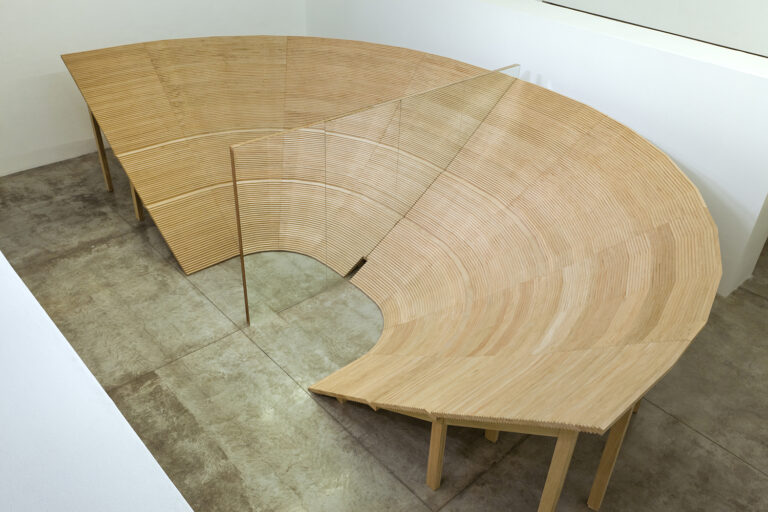
Exhibition view: Paul Pfeiffer, VITRUVIAN FIGURE, the Museum of Contemporary Art and Design (MCAD), Manila (Philippines), 2015
Courtesy of the artist and carlier | gebauer, Berlin/Madrid
Photo © 2015 MCAD Manila
Pfeiffer has had many one-person exhibitions at Whitney Museum of American Art (2001); the Museum of Contemporary Art Chicago (2003 and 2017-18); the National Gallery of Victoria, Melbourne (2005); MUSAC León, Spain (2008); Hamburger Bahnhof, Berlin (2009); Sammlung Goetz, Munich (2011); Museum of Contemporary Art and Design, Manila (2015); Inhotim, Brumadinho, Brazil (2018); and The Athenaeum, Athens, GA (2023). He has presented work in major international exhibitions, most recently the Performa Biennial and the Honolulu Biennial in 2019 and the Toronto Biennial and Seoul Mediacity Biennale in 2022. His work is in the permanent collections of the Museum of Modern Art and the Whitney Museum of American Art, New York; Museum of Modern Art, San Francisco; M+, Hong Kong; The Guggenheim; Tate Modern; and the Pinault Collection, among many others.
Pfeiffer’s first large-scale retrospective of his work at the Museum of Contemporary Art, Los Angeles (2023-24) will travel to the Guggenheim Bilbao and open November, 2024.
